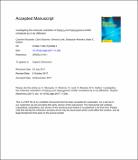Files in this item
Investigating the molecular orientation of Ir(ppy)3 and Ir(ppy)2(acac) emitter complexes by X-ray diffraction
Item metadata
| dc.contributor.author | Murawski, Caroline | |
| dc.contributor.author | Elschner, Chris | |
| dc.contributor.author | Lenk, Simone | |
| dc.contributor.author | Reineke, Sebastian | |
| dc.contributor.author | Gather, Malte C. | |
| dc.date.accessioned | 2018-11-26T00:53:10Z | |
| dc.date.available | 2018-11-26T00:53:10Z | |
| dc.date.issued | 2018-02 | |
| dc.identifier | 251107578 | |
| dc.identifier | a7e132cb-bfd3-44f2-bd6a-1694864578b0 | |
| dc.identifier | 85036471265 | |
| dc.identifier | 000418793500025 | |
| dc.identifier.citation | Murawski , C , Elschner , C , Lenk , S , Reineke , S & Gather , M C 2018 , ' Investigating the molecular orientation of Ir(ppy) 3 and Ir(ppy) 2 (acac) emitter complexes by X-ray diffraction ' , Organic Electronics , vol. 53 , pp. 198-204 . https://doi.org/10.1016/j.orgel.2017.11.036 | en |
| dc.identifier.issn | 1566-1199 | |
| dc.identifier.other | ORCID: /0000-0002-4857-5562/work/47136463 | |
| dc.identifier.uri | https://hdl.handle.net/10023/16545 | |
| dc.description | This work received funding from the European Community Seventh Framework Programme under Grant Agreement No. FP7 267995 (NUDEV) and from the European Social Fund and the Free State of Saxony through the OrganoMechanics project. CM acknowledges funding from the Graduate Academy of the TU Dresden and by the European Commission through a Marie Skłodowska-Curie Individual Fellowship (703387). | en |
| dc.description.abstract | We study thermally evaporated thin films of Ir(ppy)3 and Ir(ppy)2(acac) by means of grazing incidence X-ray diffraction (GIXRD) and grazing incidence wide-angle X-ray scattering (GIWAXS). Ir(ppy)3 and Ir(ppy)2(acac) are both widely used as phosphorescent green emitter molecules in organic light-emitting diodes (OLEDs) and it was previously found that differences in their average transition dipole orientation affect the light extraction efficiency in OLEDs. Here we show that in pure films both materials form crystalline grains and that these grains exhibit a preferred orientation with respect to the substrate. When doped into an amorphous host, both the orientation and formation of the crystallites remain nearly unchanged for the concentration range accessible with GIXRD and GIWAXS. This is remarkable given that the transition dipole moments have found to be oriented only for Ir(ppy)2(acac) but isotropic for Ir(ppy)3. Analysis of the crystallite size indicates that the tendency to form crystallites is stronger for Ir(ppy)3 than for Ir(ppy)2(acac). From a comparison of the thin-film diffraction data of Ir(ppy)3 to its powder pattern, we infer that Ir(ppy)3 molecules are oriented with their permanent dipole moment roughly parallel to the substrate. Our findings will guide the further understanding of the mechanisms controlling transition dipole orientation and may thus lead to further improvements in device efficiency. | |
| dc.format.extent | 1558613 | |
| dc.language.iso | eng | |
| dc.relation.ispartof | Organic Electronics | en |
| dc.subject | Phosphorescent iridium complex | en |
| dc.subject | Orientation | en |
| dc.subject | Organic light-emitting diode | en |
| dc.subject | X-ray diffraction | en |
| dc.subject | QC Physics | en |
| dc.subject | QD Chemistry | en |
| dc.subject | QH301 Biology | en |
| dc.subject | TK Electrical engineering. Electronics Nuclear engineering | en |
| dc.subject | DAS | en |
| dc.subject.lcc | QC | en |
| dc.subject.lcc | QD | en |
| dc.subject.lcc | QH301 | en |
| dc.subject.lcc | TK | en |
| dc.title | Investigating the molecular orientation of Ir(ppy)3 and Ir(ppy)2(acac) emitter complexes by X-ray diffraction | en |
| dc.type | Journal article | en |
| dc.contributor.sponsor | European Commission | en |
| dc.contributor.institution | University of St Andrews. School of Physics and Astronomy | en |
| dc.contributor.institution | University of St Andrews. Biomedical Sciences Research Complex | en |
| dc.identifier.doi | 10.1016/j.orgel.2017.11.036 | |
| dc.description.status | Peer reviewed | en |
| dc.date.embargoedUntil | 2018-11-26 | |
| dc.identifier.grantnumber | 703387 | en |
This item appears in the following Collection(s)
Items in the St Andrews Research Repository are protected by copyright, with all rights reserved, unless otherwise indicated.

